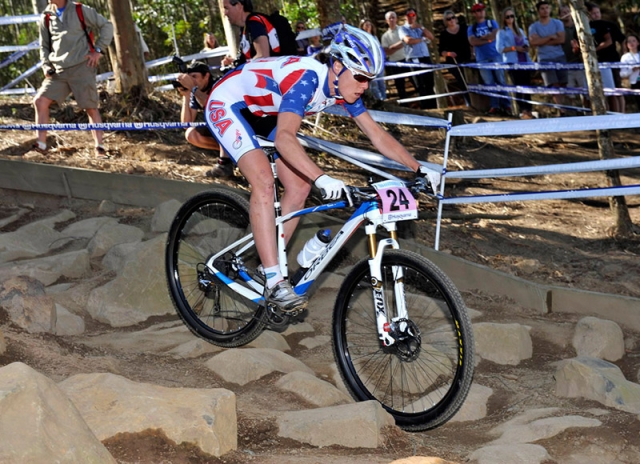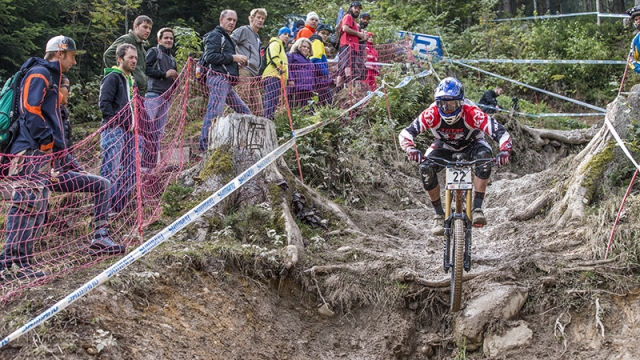|
Modern mountain biking got its start in the late 1970s in Northern California and today serves as a popular form of recreation, as well as competition. Like other disciplines of cycling, mountain biking encompasses many different formats, including cross-country, short track cross-country, ultra-endurance, downhill, dual slalom, four-cross, super D, enduro and observed trials. Want to get started mountain biking? Here are some tips from Olympian Lea Davison on giving it a try: Ready to race? Read "How to prepare for your first mountain bike race". This endurance-oriented event is a mass-start competition which typically features 100-150 riders competing over rough terrain that includes everything from unpaved fire roads to technical singletrack filled with rocks, roots and ruts. A typical elite-level mountain bike race lasts approximately two hours and ranges from 22-28 miles for men and 16-22 miles for women. Cross-country is the only mountain biking format contested at the Olympic Games. A common cross-country mountain bike course includes significant elevation gain and tricky descents. To accommodate the off-road conditions, competitors’ bikes are equipped with wide, knobby tires for better traction and suspension systems to soften the impact of riding over uneven terrain. Bike-handling skills, a keen sense of awareness and an element of bravery are all vital characteristics of a successful cross-country mountain bike racer. Similar to a criterium in road cycling, short track cross-county was introduced as a spectator-friendly discipline. It is an endurance-oriented event that features off-road racing on a short circuit. Traversing similar terrain, a short track cross-country race typically only lasts 20 minutes as competitors start and finish fast. Ultra-endurance racing comes in many forms, but is best described as off-road racing that covers longer-than-normal distances and/or lasts for several hours or more. Held on cross-country courses, marathons are defined by cycling’s international governing body as races that are 100 kilometers long or more. Ultra-endurance racing also comes in the form of 24-hour and 12-hour competitions in which solo competitors and relay teams attempt to cover the most distance over a given amount of time. One of the many “gravity” styles of racing, downhill is exactly as it sounds. Competitors descend the face of a mountain in an individual race against the clock. The rider with the fastest time is declared the winner. Some of mountain biking’s most advanced technology comes from the discipline of downhill racing. Riders compete on bikes that have full suspension systems which allow them to experience a smooth ride as they descend down rocky trails, jumps and drop-offs. Typically speaking, a mountain biker specializes in either endurance or gravity-oriented events, but not both. A downhill rider will often cross over into four-cross and dual slalom competitions. The athletes are also easily identifiable at events as the ones with full-face helmets, body armor, and pads. Considered another “gravity” event, dual slalom features two riders competing head-to-head against each other. Similar to the slalom events in downhill ski racing, competitors must weave themselves in and out of gates while descending the face of a hill. A course will typically have two identical runs – red and blue. Riders start at the top of the hill and race side-by-side on their assigned run. After the first heat, riders switch runs and descend the hill a second time. After each rider competes on the red and blue course, his or her times are added together and the rider with the lowest cumulative time advances to the next round, while the loser is eliminated. Also referred to as mountain cross, four-cross replaced dual slalom on the international circuit in 2002. In the four-cross event, gravity riders are seeded into four-person brackets following an individual seeding run. Once seeded into their respective brackets, riders descend a technical, downhill course with tight turns, berms and jumps. Riders start four-wide and descend the course simultaneously after the start gate drops. From there, the idea is simple: the top two riders in each heat advance to the next round while the two losers are eliminated from contention. Short for super downhill, this discipline is a hybrid of cross-country and downhill racing. Competitors start one at a time at the top of a mountain and traverse a long, winding, slightly downhill course. The rider with the fastest time is declared the winner. Super D differs from downhill in the sense that it doesn’t include sharp, technical descents, jumps or drop-offs. Although the course profile is downhill in nature, many endurance athletes regularly contest the super downhill. Super D differs from cross-country in the sense that there is no climbing involved. The course is built for consistent speed. The newest form of mountain biking, enduro combines technical downhill sections of a course with flat and uphill sections typically found at a cross-country race. In enduro events, however, only the downhill sections are timed. Races therefore have more than one stage, with a rider's times added together to create an overall time. Competitors typically choose bikes that allow for the bike-handling capabilities required of a downhill racer, but also don't prohibit sustained climbing. Half entertainment, half sport, observed trials feature riders who negotiate an obstacle course on their bike. The goal is to traverse the course on your bike without letting your feet touch the ground. At an observed trials competition, competitors go from station to station where they are scored based on the number of times their feet touch the ground (dabs). The person with the fewest dabs at the end of the competition is declared the winner. Courses usually feature such obstacles as boulders, rocks, stumps and other natural hurdles in addition to man-made obstacles such as picnic tables, cars, and specially built structures. |






